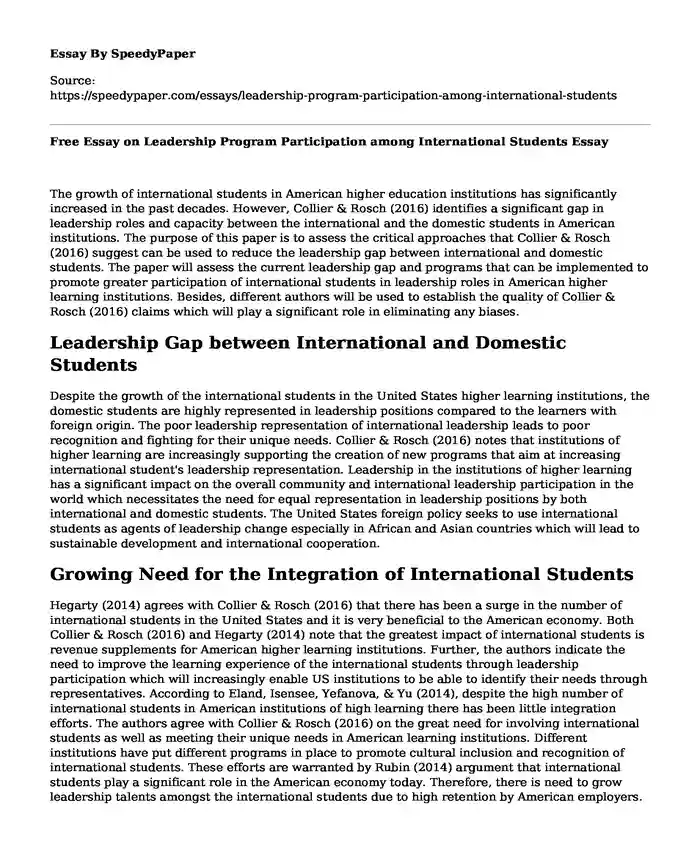
| Type of paper: | Essay |
| Categories: | Students Leadership development |
| Pages: | 3 |
| Wordcount: | 692 words |
The growth of international students in American higher education institutions has significantly increased in the past decades. However, Collier & Rosch (2016) identifies a significant gap in leadership roles and capacity between the international and the domestic students in American institutions. The purpose of this paper is to assess the critical approaches that Collier & Rosch (2016) suggest can be used to reduce the leadership gap between international and domestic students. The paper will assess the current leadership gap and programs that can be implemented to promote greater participation of international students in leadership roles in American higher learning institutions. Besides, different authors will be used to establish the quality of Collier & Rosch (2016) claims which will play a significant role in eliminating any biases.
Leadership Gap between International and Domestic Students
Despite the growth of the international students in the United States higher learning institutions, the domestic students are highly represented in leadership positions compared to the learners with foreign origin. The poor leadership representation of international leadership leads to poor recognition and fighting for their unique needs. Collier & Rosch (2016) notes that institutions of higher learning are increasingly supporting the creation of new programs that aim at increasing international student's leadership representation. Leadership in the institutions of higher learning has a significant impact on the overall community and international leadership participation in the world which necessitates the need for equal representation in leadership positions by both international and domestic students. The United States foreign policy seeks to use international students as agents of leadership change especially in African and Asian countries which will lead to sustainable development and international cooperation.
Growing Need for the Integration of International Students
Hegarty (2014) agrees with Collier & Rosch (2016) that there has been a surge in the number of international students in the United States and it is very beneficial to the American economy. Both Collier & Rosch (2016) and Hegarty (2014) note that the greatest impact of international students is revenue supplements for American higher learning institutions. Further, the authors indicate the need to improve the learning experience of the international students through leadership participation which will increasingly enable US institutions to be able to identify their needs through representatives. According to Eland, Isensee, Yefanova, & Yu (2014), despite the high number of international students in American institutions of high learning there has been little integration efforts. The authors agree with Collier & Rosch (2016) on the great need for involving international students as well as meeting their unique needs in American learning institutions. Different institutions have put different programs in place to promote cultural inclusion and recognition of international students. These efforts are warranted by Rubin (2014) argument that international students play a significant role in the American economy today. Therefore, there is need to grow leadership talents amongst the international students due to high retention by American employers. Leadership development and participation by foreign learners is a good approach to increase their involvement in local and global economies.
Conclusion
All the authors are in favor towards Collier & Rosch (2016) argument on the need to create programs to facilitate leadership participation by the international students in higher learning institutions which will increase their engagement in local and global community development. The sustainability of the high international students in American higher learning institutions needs the greater involvement of their leaders to understand their needs. Therefore, programs that seek to increase international student's leadership participation are strategically essential to tap on the talents of international students.
References
Collier, D. A., & Rosch, D. M. (2016). Effects Associated with Leadership Program Participation in International Students Compared to Domestic Students. Journal of Leadership Education, 15(4).
Eland, A., Isensee, B., Yefanova, D., & Yu, X. (2014). Seeking Best Practices for Integrating International and Domestic Students. International Students & Scholar Services. The University of Minnesota. Retrieved from https://global.umn.edu/icc/documents/14_integration_best_practices_overall.pdf
Hegarty, N. (2014). Where we are now-The presence and importance of international students to universities in the United States. Journal of International Students, 4(3), 223-235. Retrieved from https://files.eric.ed.gov/fulltext/EJ1054975.pdf
Rubin, K. (2014). Retaining international students. International Educator, 23(5), 30.Retrieved from https://www.nafsa.org/_/File/_/ie_sepoct14_retaining.pdf
Cite this page
Free Essay on Leadership Program Participation among International Students. (2022, Nov 21). Retrieved from https://speedypaper.net/essays/leadership-program-participation-among-international-students
Request Removal
If you are the original author of this essay and no longer wish to have it published on the SpeedyPaper website, please click below to request its removal:
- Free Essay Example on Fighting in Schools
- Free Essay Example on Birth Rates in Japan
- Islamophobia Research Essay Example
- Main Themes of the Novel The Awakening: Free Essay to Read
- Source Analysis Paper Sample: Fixing Inequality in Hong Kong
- Free Essay Comparing and Contrasting the Stoic, Buddhist, and Modern Psychological Perspectives
- The Women's Rights Movements - Research Paper
Popular categories




